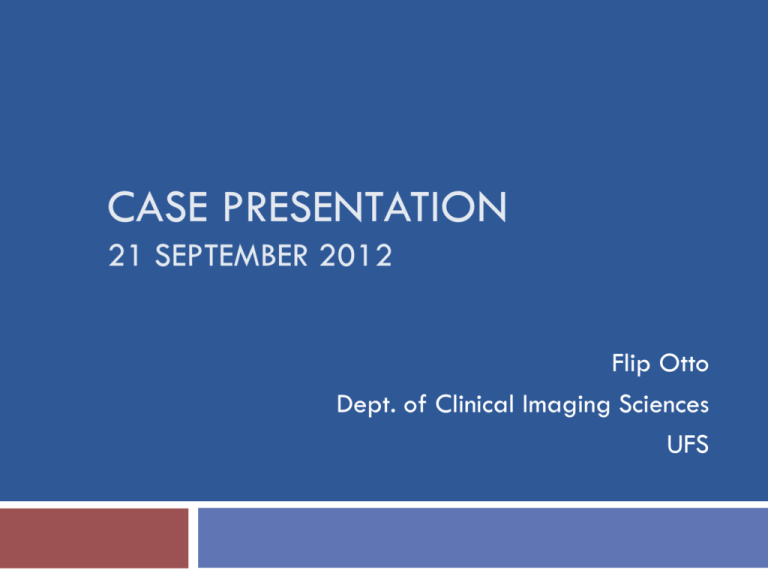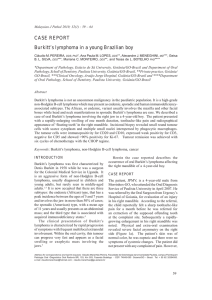22.21SeptCasePres
advertisement

CASE PRESENTATION 21 SEPTEMBER 2012 Flip Otto Dept. of Clinical Imaging Sciences UFS Clinical information 15 year old girl from Kimberly Problem list: Burkitts lymphoma/leukemia (bonemarrow biopsy confirmed Burkitt type blasts on immunophenotyping) Thrombocytopaenia, anaemia Subdural collection with mass effect on presentation HIV positive, on ARV’s since June 2012, latest CD4 count 501 Infective endocarditis of mitral valve DVT On empirical TB treatment Presented with sudden loss of vision on 19 August 2012 Clinical information (cont) Management Subdural collection drained on 14 June 2012 Intrathecal chemotherapy started (flow cytometry negative) First cycle of chemo started on 26 June, complicated by neutropenic sepsis ICU admission on 13 July for respiratory failure Transferred to ward on 10 August Patient discharged to Kimberley for further palliative management Imaging findings Initial uncontrasted CT brain on 13 June 2012: Left subdural collection (20HU) 9mm deep Left frontal dural-based density 3mm deep 9mm midline shift to the right Follow up uncontrasted CT on 28 June 2012: Left parietal burrhole Left subdural collection decreased in size with decreased mass effect Imaging findings cont. CT brain pre and post-contrast on 19 August 2012: Hyperdense subdurally based lesions with contrast enhancement, left frontoparietal and left occipital regions Leptomeningeal/cortical hyperdense lesions, with contrast enhancement, in the right occipital and left frontal lobes, with underlying subcortical white matter hypodensity Imaging findings cont. MRI of the brain on 22 August 2012: Subdurally based lesions left frontoparietal and occipital appear iso-intense to grey-matter on T1, T2, T2* and T2 FLAIR, with intense contrast enhancement Uniform, intense dural enhancement in the left hemisphere Leptomeningeal lesions left frontal and right occipital are hyperintense on T1, with contrast enhancement Underlying subcortical white matter show high signal on T2 and T2 FLAIR Diagnosis Dural metastases of Burkitts lymphoma/leukemia Differential diagnosis of right occipital and left frontal leptomeningeal enhancement and underlying white matter lesions includes subacute ischaemic infarctions with luxury perfusion, laminar necrosis and/or haemorrhagic transformation and leptomeningeal metatsases. Leukemic cells subsequently confirmed in CSF Differential diagnosis of Dural Metastases Usually hematogenously disseminated en plaque lesions from extracranial primary tumours Lung, breast and prostate cancer, as well as melanoma, known to cause dural metastases Breast carcinoma most commonly associated with purely dural metastases Dural lymphoma may be the primary focus of neoplasm Dural plasmacytoma nearly identical to dural lymphoma In children dural metastases are commonly associated with leukemia and neuroblastomas Inflammatory lesions that may simulate dural metastases include granulomatous infections, sarcoidosis, Erdheim-Chester disease and Langerhans cell histiocytosis Discussion: Burkitt’s lymphoma Burkitt’s lymphoma/Burkitt cell leukemia: Clinically most aggressive lymphoid leukemia, of B-cell origin. Association with EBV in a variable proportion of cases <1% of NHL but 30% of childhood NHL in USA Leukemia presents with widespread involvement of the bone marrow and peripheral blood. Lymphoma used for proliferations arising as discrete masses Distinction between lymphoma and leukemia often blurred Pathology Cells homogeneous in size and shape with a very high proliferative fraction Pathologists sometimes have difficulty distinguishing between Burkitt’s lymphoma and diffuse large B cell lymphoma Distinction can sometimes be made based on the extremely high proliferative fraction in Burkitt’s lymphoma Most rapidly progressive human tumour, with a propensity to metastasize to the CNS Burkitt’s lymphoma: “Starry sky” appearance at low power light microscopy High power microscopy showing multiple small nucleoli and high mitotic index Burkitt’s lymphoma: Clinical presentation Three distinct clinical forms: Endemic (African) type Sporadic (nonendemic) Immunodeficiency-associated (in HIV infection) Extranodal disease common and all three variants are at risk for CNS disease Endemic form involves jaws and orbits in 50% of cases (floating tooth sign on plain radiography) Sporadic form has predilection for ileocecal region Ovaries, kidneys and breast may be involved in both Retroperitoneal and paraspinal disease causing paraplegia is a presenting feature in up to15% of cases Leptomeningeal disease can be seen at presentation and is a site of relapse Diagnostic and staging work-up Once diagnosis of BL suspected, diagnosis and staging evaluation should be prompt Since it is the most rapidly progressing human tumour, delay in starting therapy can be detrimental to the prognosis Initial examination should always include CSF analysis to rule out metastases, in addition to standard staging investigations for NHL Treatment and Prognosis Treatment should commence within 48hrs of diagnosis Intensive chemotherapy regimens including high doses cyclophosphamide are used Prophylactic therapy to the CNS is mandatory One of the first cancers cured by chemotherapy Cure in high percentage of young patients treated effectively, but salvage therapy following relapse generally ineffective, with poor prognosis References Armitage JO, Longo DL: Malignancies of Lymphoid cells, in Harrison’s Principles of Internal Medicine, 16th ed, DL Kasper et al (eds.). New York, McGraw-Hill, 2005, Chap 97 Aster JC: Disease of the White Blood Cells, Lymph Nodes, Spleen and Thymus, in Robbins and Cotran Pathological Basis of Disease, 7th ed, V Kumar et al (eds.). Philadelphia, Elsevier Saunders, 2005, Chap 14 Vinnicombe SJ, Reznek RH: Reticuloedothelial Disorders: Lymphoma, in Grainger & Allison’s Diagnostic Radiology, 5th ed, A Adam et al (eds.). Churchill-Livingstone, 2008, Chap 72 Yousem DM, Grossman RI. Neuroradiology: The Requisites, 3rd ed. Philadelphia, Mosby, 2010, p.65-67






